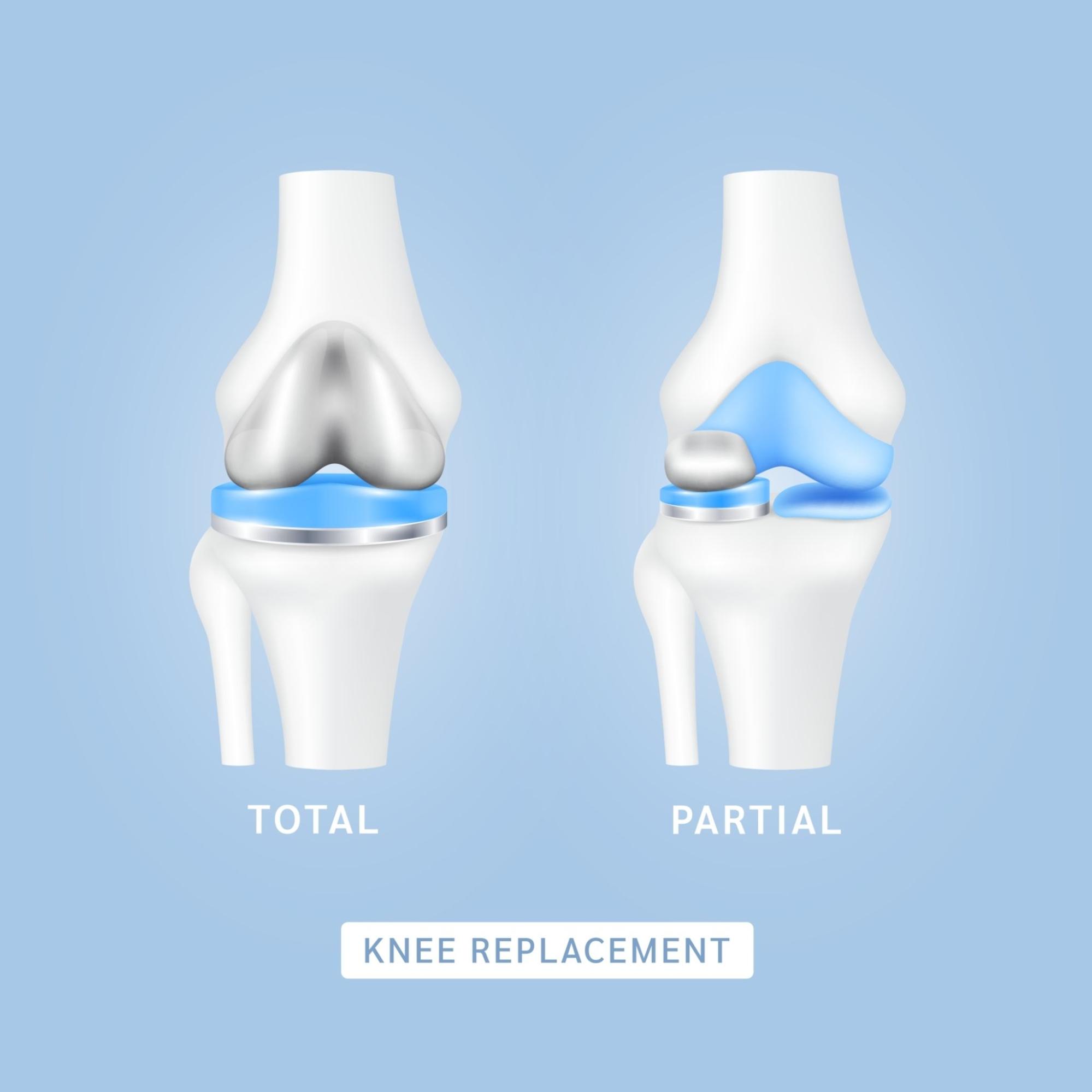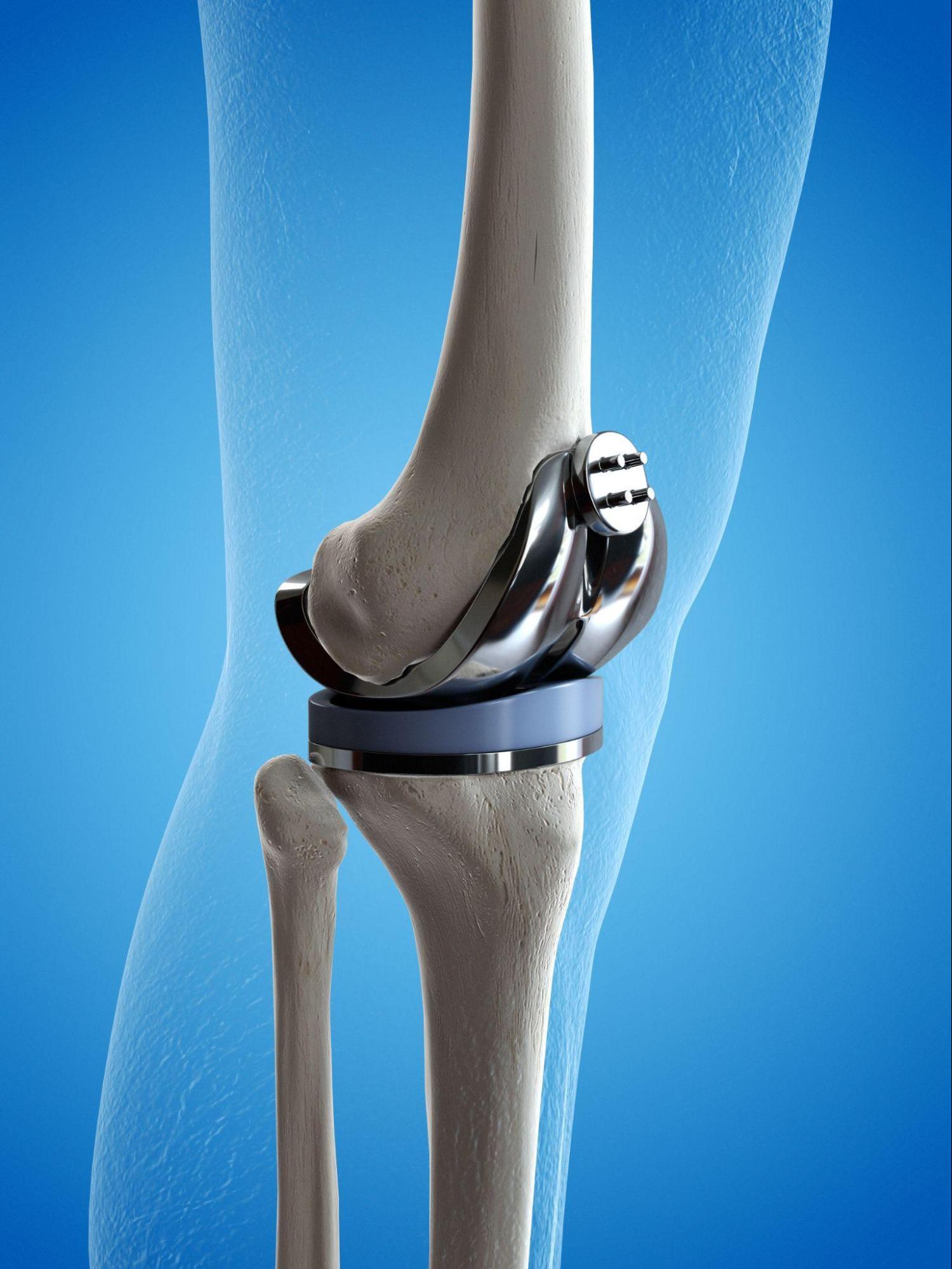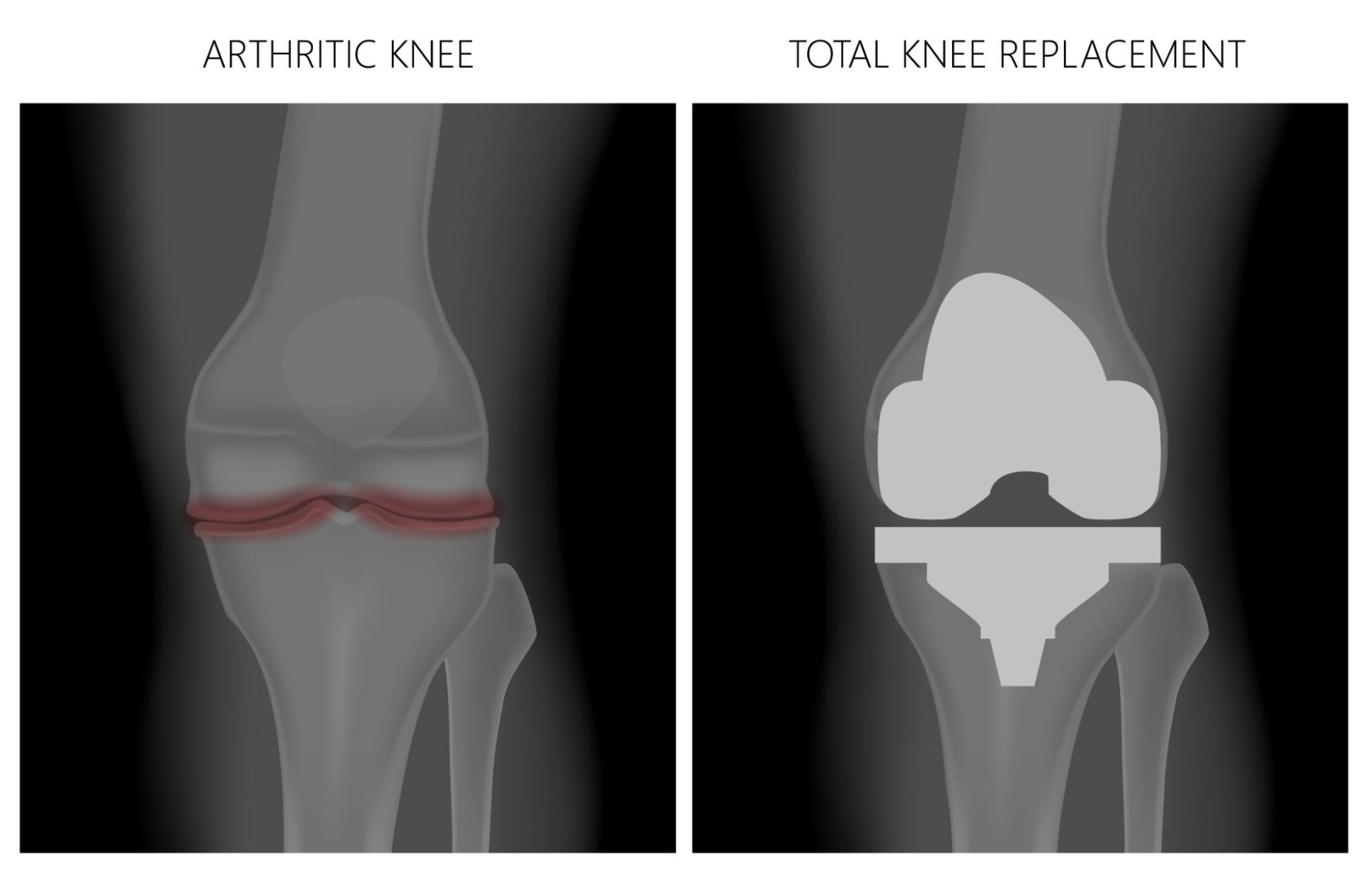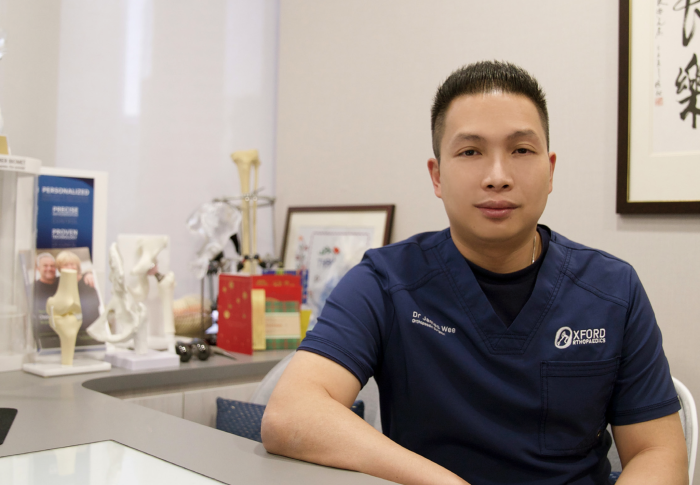
Arthritis of the knees is a common ailment that can affect anyone, from athletes to the elderly. It commonly manifests as knee pain, swelling, or stiffness. If you have these symptoms and pain medication isn’t helping anymore, you may have knee arthritis, and you should consult with your doctor to determine if knee replacement surgery is needed.
What Is a Knee Replacement?

Knee replacements are surgical procedures that relieve pain and restore knee mobility. They are often performed on people with knee arthritis and knee injuries.
During a knee replacement, damaged bones, cartilage, and ligaments of your knees are removed and replaced with artificial implants. These prosthetic implants are designed to replicate the shape and texture of natural knees and function similarly.
Traditionally, a 20 to 30 cm incision is made in the knee to expose the joint, the affected tissue is removed, and knee implants are inserted into place. At Oxford Orthopaedics, we offer robot-assisted knee replacements for enhanced accuracy. This provides minimally invasive options for both total and partial knee replacements, known as Unicompartmental Knee Replacement (UKR), which we will discuss shortly.
What Are the Key Differences Between a Partial Knee Replacement Vs a Total Knee Replacement?
Two key types of knee replacements exist: total and partial. To help you decide which surgery to choose, we’ll give you a quick overview of the differences between a partial knee replacement (UKA) and a total knee replacement (TKR).
The table below provides an overview of the main differences between a UKA and a TKR:
| Partial Knee Replacement (UKA) | Total Knee Replacement (TKR) | |
Suitability |
|
|
Surgical Procedure |
|
|
Advantages |
|
|
Disadvantages |
|
|
What Are the Benefits Of a Partial Knee Replacement Relative to a Total Knee Replacement?
More Natural-feeling Knee:
During a partial knee replacement, the knee’s ligaments unaffected by arthritis are preserved. This means that there is more of your own body part that remains intact, which makes for a more natural sensation (proprioception) post-surgery. A lot of patients feel more comfortable with that.
Less Invasive and Lower Risk of Complications:
Partial knee replacements also have a lower risk of serious complications as there is less bone and soft tissue dissection than total knee replacements.
Shortened Hospital Stay:
In most cases, partial knee replacements also offer a faster recovery time, potentially shortening your hospitalisation stay.
What to Expect After a Total and Partial Knee Replacement Surgery?
Both total and partial knee replacements are generally very effective operations that produce good post-surgical functional outcomes. Returning to daily activities typically takes several months after a partial or total knee replacement.
The recovery process for both types of knee replacement is very similar, aside from the difference in recovery time. Regarding pain management, orthopaedic surgeons will prescribe pain medication and anti-inflammatory drugs such as NSAIDs to manage the swelling. It is normal for some swelling to take months to subside fully, even when a patient fully recovers with no pain or discomfort.
How well an individual recovers from knee replacement surgery depends on their rehabilitation programme. Physical therapy, such as walking, is highly recommended to restore functional mobility to the knee joints. Usually, a patient recovering from total knee replacement can walk with assistance post-surgery and walk normally within a few weeks. It is important to slowly increase the periods of walking or other low-impact activities to ensure that you can fully recover without injuring yourself.
At Oxford Orthopaedics, we will always guide you throughout the rehabilitation process, so never hesitate to ask questions about problems or concerns regarding your recovering knees.
Who Are Suitable Candidates for Partial Knee Replacement and Total Knee Replacement?
Partial Knee Replacements or Unicompartmental Knee Replacement (UKR)

People with the following traits tend to be suitable for UKA:
Early-Stage Arthritis Limited to a Specific Part of the Knee (Medial Compartment Knee Arthritis):
Partial Knee Replacement is optimal for patients with arthritis restricted to a single compartment of the knee, typically the medial compartment. This procedure allows for the damaged part to be replaced while preserving the healthy parts of the knee, which can lead to a more natural feeling post-surgery. The limited scope of the surgery often results in less disruption to the knee’s overall anatomy and can maintain more natural knee mechanics.
Good Range of Motion:
PKR is well-suited for patients who still have a good range of motion in the knee. The procedure typically allows for the preservation of this range, potentially leading to a more natural feeling during movement post-operation.
Total Knee Replacements (TKR)

People with the following traits are usually suitable for TKR:
End-stage Knee Arthritis that Affects Multiple Knee Compartments :
TKR is recommended for patients with severe arthritis that affects multiple knee compartments. This procedure involves replacing all the knee joint’s components, which can alleviate pain from severe arthritis more comprehensively than PKR.
Knee Pain That Causes Severe Impediments
TKR can be a more effective solution for individuals whose knee pain significantly hampers daily activities to the extent that they can no longer perform daily activities like walking, running and climbing stairs TKR aims to significantly reduce pain and restore function by replacing the entire knee joint, improving the quality of life for patients with debilitating knee conditions.
Decreased Mobility:
Patients with reduced mobility due to extensive joint damage or stiffness might benefit more from TKR, as it provides a new joint with the potential for greater mobility compared to a deteriorated natural knee. TKR can allow these patients to regain a functional range of motion.
Most people with these conditions are old, but total knee replacement can also be beneficial for younger people who have developed knee arthritis through injury.
Please note that these guidelines are not completely strict. You should discuss your concerns and desired results with your surgeon to determine the right type of knee replacement for you.
Also, a few patients may still opt for total knee replacement despite being eligible for partial knee replacement due to personal preference because a total knee replacement can seem permanent.
How Would I Know What’s Suitable for Me?

After a thorough evaluation by an orthopaedic surgeon, you will be offered various treatment options. Although only one surgical option will typically be recommended, patients who wish to consider alternative treatments can refer to the table above and discuss the pros & cons of both surgeries with your orthopaedic surgeon. Overall, the decision between TKR and PKR is made collaboratively between the patient and the surgeon based on the patient’s specific medical condition, lifestyle, and preferences.
Takeaways
Both total and partial knee replacements can be beneficial in treating knee arthritis and alleviating chronic joint pain. However, not everybody is suitable for both procedures. Physically active individuals and those with end-stage knee arthritis may be advised to go for a total knee replacement. Patients who still maintain a good range of motion before surgery might be suited for partial knee replacement.
At the end of the day, consulting an experienced orthopaedic surgeon in Singapore before proceeding is key to a successful procedure. He will thoroughly evaluate your condition and recommend a surgical option suited for you.
Visit Oxford Orthopaedics

For tailored medical advice regarding your suitability for total or partial knee replacement, you can book an appointment with Oxford Orthopaedics’s Senior Consultant Orthopaedic Surgeon and Medical Director, Dr James Wee. With almost 20 years of clinical experience, Dr Wee has helped numerous patients recover from knee problems and enjoy an enhanced quality of life.
Dr Wee received extensive training in partial knee replacement with the acclaimed inventor-surgeons of the Oxford Partial Knee System, and witnessed first-hand how minimally-invasive partial knee replacement resulted in less pain after surgery, with safer, faster and enhanced recovery compared to total knee replacement. Moreover, he is well-versed in Robot-Assisted Knee Replacement (Mako, ROSA, NAVIO) as well, which typically leads to enhanced accuracy, swifter recovery and improved functional outcomes.
Our specialist clinic is conveniently located at Mt Elizabeth Hospital, Mt Alvernia Hospital and Farrer Park Hospital, and we provide knee replacements for those living in Singapore.
References
- Jonathan Cluett, MD.Knee Replacement Surgery: Overview. VeryWell Health; 2023 https://www.verywellhealth.com/considering-knee-replacement-surgery-2549550
- Daniel Yetman, Daniel Wiznia, MD. What is Involved in a Partial Knee Replacement?. Healthline; 2022 https://www.healthline.com/health/knee-pain/partial-knee-replacement
- Campi S, Papalia GF, Esposito C, et al. Unicompartmental Knee Replacement in Obese Patients: A Systematic Review and Meta-Analysis. J Clin Med; 2021 https://www.ncbi.nlm.nih.gov/pmc/articles/PMC8397050/
- van der List JP, Chawla H, Zuiderbaan HA, Pearle AD. The Role of Preoperative Patient Characteristics on Outcomes of Unicompartmental Knee Arthroplasty: A Meta-Analysis Critique. J Arthroplasty; 2016 https://pubmed.ncbi.nlm.nih.gov/27172863/
- Meding JB, Meding LK, Ritter MA, Keating EM. Pain Relief and Functional Improvement Remain 20 Years After Knee Arthroplasty. Clinical Orthopaedics and Related Research®. 2011;470(1):144-149. doi:https://doi.org/10.1007/s11999-011-2123-4
- He Y, Xiao L, Zhai W, Kasparek MF, Ouyang G, Boettner F. What Percentage of Patients is a Candidate for Unicompartmental Knee Replacement at a Chinese Arthroplasty Center? The Open Orthopaedics Journal. 2018;12(1):17-23. doi:https://doi.org/10.2174/187432500181201001
